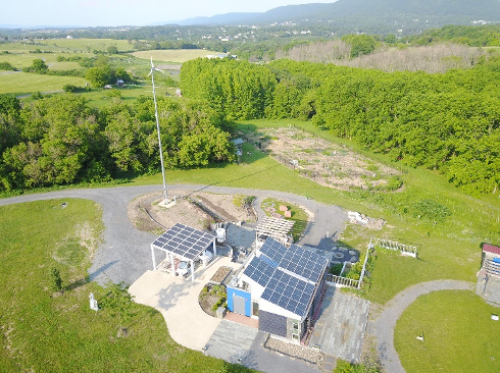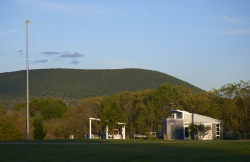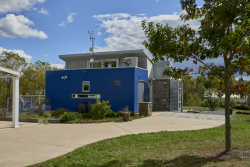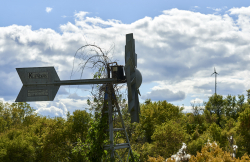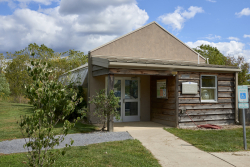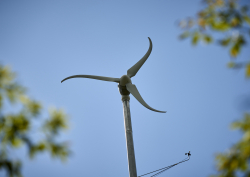Writing a Sustainable Future: SEC Creative Writing Project
Writing a Sustainable Future: SEC Creative Writing Project
Participants will first take a ‘written tour’ of the Sustainability Experience, learning about the different projects at the site as well as the site’s history. Then, they are asked to complete a 30-minute exercise to respond to a writing prompt of their choice. There is an option to have students upload and share their writing projects to the Sustainability Institute at the end of the exercise.
(Download the word .doc of the below exercise)
Welcome to Penn State’s Sustainability Experience Center. The site you are visiting is a site of continual change. We offer it to you to reflect on history and adaptation, on how we live and on what you value. What kind of world would you like to live in?
Please take some time to read the prompt below, then write freely for 30 minutes (or more), and then submit it to us. If you are a teacher or student in a writing class, we invite you to use the Sustainability Experience Center for your own flash fiction, short story, poetry or creative non-fiction writing assignments.
Let’s begin by exploring the Sustainability Experience Center’s nine acres. You can learn about each of the amenities online. We also hope that you will go to visit the site in person someday. For now, get to know what is located on the property, what surrounds it, what’s just out of sight, and what used to be here.
Then…. take some time to write a story about you in this place.
Perhaps you are…
…the last person, last family, or part of a very small group of people left on the Earth… at least as far as you know…
…the descendant of Native Americans who lived here on a route between Lake Erie and the Chesapeake Bay…
…a wife, husband or partner here to join a workday even as you try to work through a family tragedy…
…a bee pollinating the yarrow in the pollinator garden, an English Sparrow, American crow, Red-tailed Hawk or a doe in search of food.
…just here to learn and quietly reflect.
The Grounds
The Sustainability Experience Center features early 21st century sustainable technologies and practices. The MorningStar Solar Home was an experiment in solar power, extreme efficiency in energy, water and space, local materials and even cleverness. Right next to the MorningStar, you will see the Windstream turbine. If the wind is blowing, it is generating electricity. There are also small permaculture gardens and fruit trees. On the southwestern edge sits the Eco-Machine™, also solar-powered. It uses a designed aquatic environment to process thousands of gallons of wastewater each day. Our Community Garden plot affords dozens of students and community members the opportunity to grow their own food and flowers, as well as programming to learn more about gardening. Ringing the site’s edge, you will find plots of walnut, oak, and sweet gum trees used for basic research. There is also a stand of box alder trees. In the northeastern corner, you will see a small shed that has instrumentation monitoring the small wind turbine.
These nine acres are connected to much more than what’s obvious at first sight. Facing north and turning counterclockwise, you will see Medlar Field, Beaver Stadium, the Bryce Jordan Center, the indoor track, research buildings, and many dozens of acres of parking. Stormwater flows from much of the impervious surface into culverts that empty into a drainage way marking the southern boundary of the SEC. Continuing south, you would pass a natural gas-powered co-generated steam plant and livestock research. Just under a half mile to the south are the Centre Furnace Mansion, a historic home of the iron industry, and one of the late-19th century furnaces. Past that lie the Thompson and Walnut Springs and still fairly intact tracts of suburban forest amid housing, commercial and SR 26 development. Back up to the site and heading east along the drainage way, water flows into the Bathgate Pond, a regulated dam facility. There, water infiltrates into the karst, some of it emerging from Bathgate Spring and into Millbrook Marsh, a publicly funded nature center where the spring’s waters meet Thompson and Slab Cabin Runs, two of the streams feeding the main branch of Spring Creek in the suburban neighborhood of Houserville.
History
Tens of millions of years ago, this land was part of an enormous and tall mountain chain much like the Rockies. Thousands to hundreds of years ago, it was a deep primeval forest rich in wildlife. Much of it still lives, but its numbers are greatly diminished.
Distinct and diverse tribes of Native Americans lived on this land for thousands of years. Over the millennia, they innovated practices and technologies for hunting, fishing, farming, cooking and making pottery, navigating many routes between the Great Lakes and the Chesapeake Bay, and creating methods for long-distance communication. By the mid-18th century, Anglo-European colonists had practically extirpated Native people from this area.
In the middle of the 19th century, iron and agriculture dominated this land. Down the hill, you can see the iron furnace across from the Centre Furnace Mansion. That site was part of a village where iron was produced. This furnace and hundreds of others were fed by trees from all over the state, and such were their productivity that hardly a tree could be seen for miles. Joseph Rothrock called the landscape “the Pennsylvania desert.” It may seem hard to believe today, as lush forested mountains, streams and hollows are all around you.
Moses Thompson, who resided in Centre Furnace Mansion, joined with his partner James Irvin to donate 200 acres of this land to become the Farmer’s High School of Pennsylvania. With the signing of the Morrill Act by Abraham Lincoln, this institution would eventually become one of the nation’s land grant universities, Penn State. Centered around the University, the town of State College emerged in this valley over the next several decades.
Since World War II, the human population of the State College area—called Happy Valley or the Centre Region—has grown rapidly. Penn State has become one of the nation’s leading research and teaching universities, graduating hundreds of thousands of students who have gone on to fill just about every role in society. The land, water and air that you are breathing right now and all of the human settlement you see today has been influenced by Penn State.
As you look around the landscape, think about the systems running through the site…..
- What are the systems of food, water, and energy that are on and flow through this site and its neighboring areas?
- How have the flows of these systems changed throughout the history of the site?
- How could they change to be more sustainable for all in the future?

